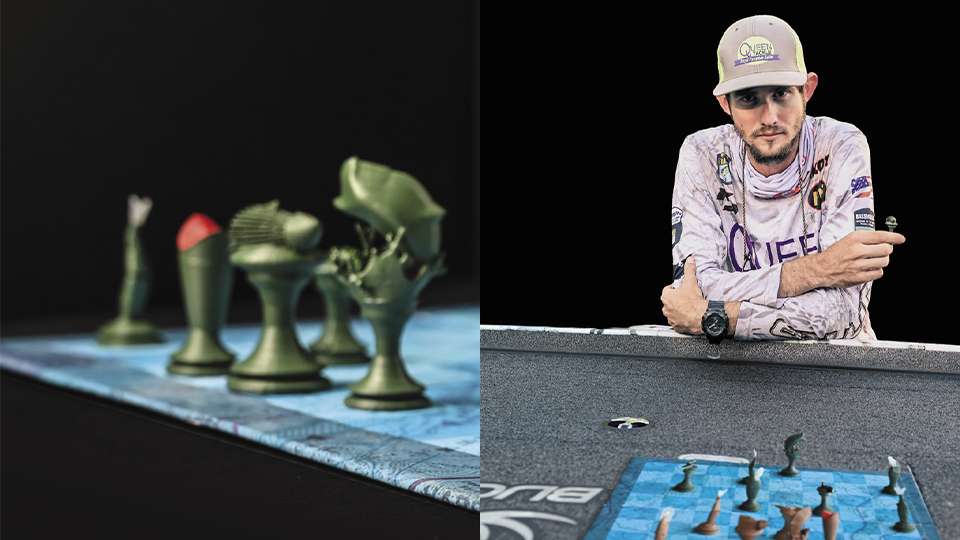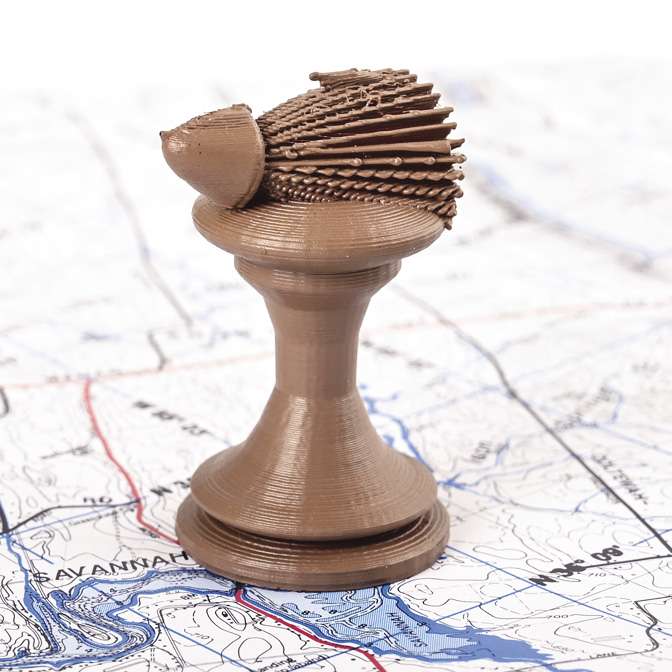
Focus. An intense gaze beaming from the eye of the competitor. Peer across the bass fishing landscape and you’ll see dozens of thousand-yard stares in each field every weekend. They’re the mark of the competitors who are locked in, the men and women playing a game beyond what they see on the water, those busy casting, catching and playing the game of chess going on beneath the waves.
Tournament fishing has often been likened to the game of chess, a battle dating back 1,500 years where the pieces on the surface rarely reveal what’s going on behind the scenes. As in fishing, the basic moves are simple: cast, retrieve, move up, move down. Pause the bait. Hasten the retrieve. The pieces move this way and that. But as in chess, the winning moves often go beyond the basics.
While each angler has his favorites, we tapped one of the brightest rising stars on the Elite Series to break down his top techniques for the more reliable lures in his arsenal. Here’s how KJ Queen sees those pieces fitting together on tournament days.

The Pawn – Senko
The most reliable piece on the board, pawns are abundant, durable and surprisingly powerful. These overlooked foot soldiers can take down the mightiest knight if they’re put in the right position at the right time. Such is the case with the humble Senko, an unassuming soft plastic that is probably sitting by the dozens in your tacklebox right now.
Queen deploys the Senko with the same lethal efficiency as his Elite Series peers in lakes across the country, but he offers a twist on the strategy of his competitors. “If fishing conditions are supertough and I can’t get a bite anywhere,” he says, “I like throwing a 4-inch stickworm that’s just a little different than what everyone else does. Most guys throw a 5-inch worm, and this gives them something different that they probably haven’t seen much of yet.”
On The Board: Beginners may know that pawns can move a single space forward on each turn or two spaces forward on their first turn. But did you know pawns can also become other pieces? Pawns can earn a promotion if they navigate to the other side of the board. They can be promoted to any piece other than king. That’s right; even if you have a queen on the board, you can add an extra. Think of it like finding a real kicker with a humble soft plastic.
The Knight – Jenko CD7 Crankbait
Erratic knights cut L-shaped swaths across the chessboard, sniping unsuspecting opponents from well-defended perches with speed. Enter the humble crankbait, a ubiquitous piece of fishing tackle with a seemingly endless array of variations and an often erratic action. “I feel like nowadays there are so many techniques and ways to fish a crankbait,” says Queen. “Everyone can watch YouTube and see that you go down a rocky bank and throw a squarebill.”
To fight the crowd, Queen zigs when they zag with a medium-diving Jenko CD7 Silent crankbait. He says the Silent lure helps tempt highly pressured fish with a less intimidating meal that doesn’t produce the same knocking sounds that accompany many other baits on the market. “It covers water quickly, but it also has the ability to sort of sneak up on the bass in a way that is more natural to them,” he adds.
On The Board: Knights can create an outpost. Outposting is a technique in which a knight occupies an early defensive position near the center of the board, usually surrounded by pawns from both sides. This allows the knight to maintain control over a wide swath of the playing area while leveraging its mobility to assist other pieces in a future attack. The risk-reward play is reminiscent of anglers who cluster waypoints and linger in the right areas until the winning fish turn on.

The Bishop – Rebel Pop-R
Looming sentinels of the chessboard, bishops rub shoulders with royalty while packing a potent punch. A bishop can streak diagonally across the board in an instant or hover in place, carefully biding its time before landing a heavy blow. One could argue that the venerable Pop-R holds just such a place in the pantheon of fishing tackle. Often a sidekick to the legendary Zara Spook and not quite the fast-paced showman that the buzzbait is, the Pop-R is nonetheless a powerful tool — one that Queen uses in a unique manner.
“I like throwing a Pop-R when you can see the fish eating topwater but you can’t get them to commit to a bite,” he explains. “I throw it in the strike zone and literally let it sit. It just stays there, watching and waiting. You don’t have to do anything to it sometimes. The feather takes care of that, and you can just sit and pop it. Agitate the fish with your presence until they can’t stand it anymore and they take the bait.”
On The Board: The fianchetto is a special move sequence that moves bishops into the fray quickly. The move is executed by first pushing a pawn one or two squares forward, then freeing the bishop behind it to take command of the center of the board. This establishes early control of the playing field in a way that a hot, early morning topwater bite could put you in command at the beginning of a tournament.
The Queen – Queen Tackle Switch Blade
Fingertips quiver and minds begin to spin when Her Royal Majesty enters the fray. The queen is by far the most versatile, lethal piece on the board and is often the tipping point in pitched battles between evenly matched foes. To break the stalemate in tournaments, Queen turns to a homegrown beauty stowed carefully in his bag of tricks: the Switch Blade.
Appropriately manufactured by Queen Tackle, this dynamic add-on can turn any lure with a vertical eye into a vibrating jig-like bait. “Wind it slow, stroke it off the bottom and run it over grass, rock and timber,” says Queen. “I like to attach it to a Queen Tackle Swim Jig with a tungsten head. When the blade starts banging against that tungsten, it produces a completely different sound than what fish are used to hearing. I know for a fact that it gets extra bites and catches bigger fish. It’s a killer, no doubt.”
On The Board: A discovered attack happens when one piece creates an attack for another — like the Switch Blade adding just the right punch to a swim jig. Discovered attacks are used to create high-pressure situations that force competitors into uncomfortable decisions. Queens are masters of this strategy. Often lying in wait with a nearly unlimited reach on the board, their threat can be uncovered at pivotal moments in the battle, forcing the opposing player to completely change their strategy.

The Rook – Jenko Booty Shaker
Fast, intimidating and capable of streaking across the board in long strides, the rook can be the big game hunter of the chessboard. Crucially, its wide berth makes it a masterful defense piece. Likewise with the swimbait, a lure with prolific range and the ability to boat big bass and build big leads with reckless abandon.
Queen’s rook of choice? The Jenko Booty Shaker, a 6-inch swimbait with a gigantic paddle tail that dips, dives and flutters around ledges where lunker largemouth lurk. Though anglers across the field deploy similar swimbaits to cover territory quickly, Queen likes to take his time with the big thumper. “A huge key to success there is to stop and pause the bait,” he says. “I like to give it at least a two-second pause. Count one, two, and let the bait have a slow fall, almost as if it’s dying.”
On The Board: Castling is a special move shared by rooks and kings. It’s the only move in chess where one piece can jump another. When an open space exists between a king and rook, a player may use the castling strategy to move the king two spaces closer to the rook, while also allowing the rook to jump over the king — thus offering a tight defense against attackers. Imagine locating ledge bass with a swimbait and hauling in a monster on the same spot with a jig.

The King – Queen Tackle Flipping Jig
Benevolent, wise and clutch when you’re in a bind, the king goes nowhere quickly but goes anywhere he wants eventually. Much like a jig, this versatile piece is best used in the hands of a patient tactician who picks his spots. “For me, that’s a Queen Tackle 3/8-ounce flipping jig,” explains Queen. “I take that jig all over the country, and anywhere I go, I absolutely have that tied on because I have caught so many fish with it. No matter where I am, it is on deck.”
No game of chess is won without the king, and few fishing tournaments are as well.
On The Board: Like your favorite custom jig, kings can be vulnerable to catastrophic failure. The scholar’s mate is one of the fastest ways to win or lose a game of chess. This four-move sequence uses a bishop and a queen to attack a pawn adjacent to the king. The sequence uses a bishop to screen a queen, which captures the f7 pawn, exposing the king to immediate, fatal disaster. If you’ve ever lost a tournament to a local in the opening hours of the first day, you can relate.
Originally appeared in Bassmaster Magazine 2022.





